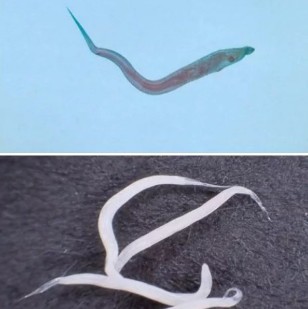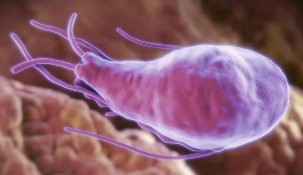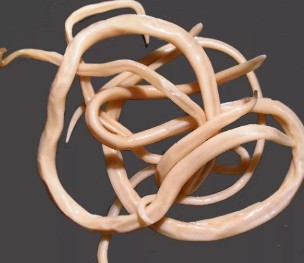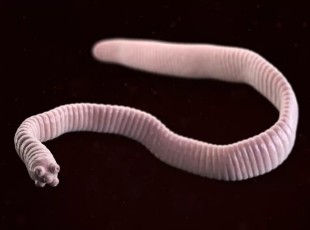Kinds of parasites in the human body is extremely diverse. Their number together with the lot-mobile and protozoa also include viruses, bacteria and fungi that are parasitic at the expense of the human body, even when in the medical tradition of the viruses and bacteria, it is not accepted to be attributed to parasites.

In the human body are different kinds of parasites localized not only in the intestines, as is commonly believed, but also in many other organs: in blood, tissues, muscles, joints, the brain (brain and spinal) and even in the eyes.
Particularly exposed to their action as internal organs such as GIT, liver, lungs, heart.
Stay parasites in the human body, it is far from harmless. Their harmful effect consists primarily in the fact that they absorb a considerable portion of the entry with food useful substances, without which the full functioning of the organism is impossible.
Imbalance is the total intoxication of the human body through the toxins secreted by the parasites, which can lead to the development of a number of diseases to malignant. Often a disease caused by parasites, are chronic in nature.
A particular danger lies in the fact that parasitic diseases cause symptoms characteristic of the other, most commonly an intestinal infection, and therefore it is of great importance for early differential diagnosis to identify the species of the parasite and to design adequate therapeutic tactics.
Types of parasites of man in general, and, in general, can be divided into two large groups:
- ectoparasite, parasitic on the body surface and the power of the blood of humans (bedbugs, fleas, lice, ticks); serves as a vector of pathogens, such as infection, such as encephalitis, typhoid, anthrax, etc.;
- endoparasite parasitic on the internal organs and lead to serious diseases; these include protozoa (giardia, amoeba, Trichomonas, Toxoplasma) and helminths – parasitic worms (worms).
Classification of parasites

Let's discuss the basic types of endoparasites of man. The appearance of many of them can be discerned only under a microscope, and some, especially from the ranks of deworming, amaze them with your size. Let's start with the easiest:
- Giardia along with dysbiosis are also the cause of IMR, anemia and general intoxication of the organism.
- Toxoplasma affects the brain, eye, heart muscle, central nervous system, but a particular danger is for pregnant because of the risk of fetal death or severe defeats him.
- Amoebae are capable of causing amoebic dysentery, amoebic encephalitis and other dangerous diseases.
- Trichomonas are a source of infectious diseases of the genitourinary system.
The most common parasites
The most common endoparasite belong to the helminths (worms), which, according to various sources, infected more than 80% of the population of the planet.
A huge number of these parasites are divided into basic types:
- hookworm – roundworm (ascaris, pinworms, Trichinella, whipworm, etc.);
- cestodes – tape worms (lantecy, pig and bullish tapeworm, Echinococcus, etc.);
- flukes – worms-happiness (liver, blood, lung, as well as lucky, living in the intestine).
Sometimes you can stumble on more than the overall classification, according to which all types of parasites, people, are divided into:
- intestinal, parasitic in the intestines;
- cloth, localized in other organs and tissues.
However, the majority of deworming in different stages of their life cycle go through and cloth, and disorders of the developmental period with the corresponding symptoms.
Let's take a brief description of the most common types of de-worming.
Roundworms (hookworm)
- Ascaris – are the most common roundworms in lengths from 20 to 40 cm, are parasitic in the small intestine, but in advance of the move in the human body, hitting the circulatory system and the respiratory system. Along with the intestinal problems these parasites can occur in the liver and gall bladder, heart and lungs. A common symptom of ascariasis – an allergic reaction.
- Pinworms – small worms up to 1 cm, affecting the intestines and leads to enterobiasis with impaired functioning of the digestive system, fatigue, sleep disorders, etc. the Characteristic sign of the presence of pinworms – itching in the anus, where they lay their eggs.
- Trichinella – these microscopic worms (their size is only a few millimeters) lead to the most difficult diseases – trichinosis, which no treatment can lead to death. Adults of the species inhabit in the body of the people in the muscles (respiratory, face, etc.), which causes muscle pain, fever, swelling, allergic rashes on the skin.
- Vlasoglavy – small worms (length up to 4.5 cm, the front part of the body

The larvae that cause trichocephalosis with diarrhea, acute abdominal pain and other symptoms that resemble appendicitis. In consequence of the intoxication of the organism develops anemia.
Tape worms (cestodes)
- Broad tapeworm, the length of the body, which reaches up to 10 m, leads to the development of the difillobotrioz with nausea, weakness, vomiting, unstable chair, asthenia and anemia.
- The pig tapeworm has a length of from 3 to 8 m, the parasite mainly in the small intestine and causes two disorders: taeniasis with the dyspeptic, asthenic-neurotic and abdominal syndromes, and cysticercosis with intoxication, intestinal, allergic, and respiratory syndromes. Depending on the localization of tsistitserki affects the muscles, brain, heart, eyes, etc.
- Bullish tapewormwhose length may reach up to 18 m, causes beef tapeworm infection, and is considered one of the most dangerous species of worms. If not do dehelmintization, can live in the human body for up to 18-20 years! Localized in the large intestine, causes severe intoxication products of his life, as well as diarrhea, nausea, vomiting, abdominal pain, anemia, allergic reactions and problems with the nervous system.
- Dwarf tapeworm long, 1.5-5 cm, – the source of the gimenolepidoz with dyspeptic, pain and asthenic-neurotic syndromes, from which suffer particularly from the digestive and nervous system of the body, and also liver.
- Echinococcus is considered to be a small caterpillar worm – its length is only 2.5 to 8, rarely 9 mm, but the assault on them has dire consequences in the form of damage to the liver and lung where they form cysts and tumors, which cause dysfunction of these organs.

Worms-luck (flukes)
- Liver fluke, or liver Fluke shape resembles the leaf of a length of 30-50 mm and a width of 8-13 mm, has a suction cup. It damages the shell of the liver and blockage of the bile duct, it is able to completely block the flow of bile. Can cause cirrhosis, hepatitis and liver cancer.
- Cats (siberian) coincidence, or a cat, Fluke, flat worm length 4-13 mm. Localization – channels of the gallbladder, liver and pancreas. Causes opisthorchiasis with the development of gastritis, ulcers, pancreatitis, cholecystitis and up to the cancer of the liver, which can lead to deadly.
- The lung fluke has ovate-shaped, reddish-brown body with fine spines in lengths from 7.5 to 12 mm with a width of 4-8 mm. Affects the lungs, causing inflammation, exudative inflammation of the pleura, focal fibrosis and lung cancer. When the penetration into the brain causing inflammation and meningoencephalitis.
- Shistosoma (blood cells luck) – dioecious worms about the size of 1-2 cm, on the eggs, which cause enlargement of the liver, spleen and lymph nodes, the education of polyps in the intestines, diarrhea, granulomatous inflammation, leading to cancer of the bladder.
The source of infestation

Helminthiasis can lead to many health problems, reducing life to 15-25 years. Many parasites is very difficult to detect. They can be anywhere - in the blood, intestines, lungs, heart, brain. Symptoms wormNoah parasitic disease may be confused with SARS, gastrointestinal diseases, and more. The main error is in these cases - tightening! If you suspect you have parasites, then you need to contact a specialist. If we talk about medications and self-healing, then of the most common deworming (Ascaris, roundworm, tapeworm) is suitable antiparasitic complex.
Helminthiasis, as well as other intestinal diseases, most often the "disease of dirty hands", what causes that get out of the eggs and larvae, worming in the human body:
- if not wash hands after toilet and before eating;
- not wash the vegetables, fruits and herbs, which are eaten in the raw state;
- they are not meant to be meat and fish, sufficient heat treatment;
- when the consumption of badly salted fish and sebum;
- keep food products readily available for flies and cockroaches;
- use the feces as fertilizer on the garden places;
- the limelight is not designed for this water;
- contact with street animals.

However, and since your pet can become infected with worms, because often animals serve high lords for the deworming and the main host is man.
Methods of struggle
- From an early age, instill in children a habit to wash your hands. They have to do this more often, because they are constantly digging in the sand, the earth, the puddle, where the most favorable conditions for eggs and larvae of parasites, and contact with domestic and street animals.
- Upon the occurrence of any of the disease cannot be excluded helminthiasis, so it is recommended to carry out an appropriate examination for parasites, to determine whether a particular type of helminth (against most of them there are medications.
- If parasites are detected in one family member, medication helminthiasya must accept all.
- Folk medicine it is known many ways to get rid of the worms, and give a good effect.
- Do not leave open dishes, bread, pastries, etc., to flies or cockroaches – vectors of eggs of worms – let products.
- Carefully observe the temperature regime in the process of cooking: meat and fish, in which often occur eggs worming, good cook/fry/bake.
- Rinse well in running water, vegetables, fruits, herbs, which are eaten in the raw state.
- Conduct regular de-worming pets.
- Refrain from the use of feces as fertilizer on your garden area.
- When traveling to exotic countries very carefully treat with dishes of the local cuisine, and especially offered on the street – there is no guarantee that with them you're not insert a no less exotic vermes.






































